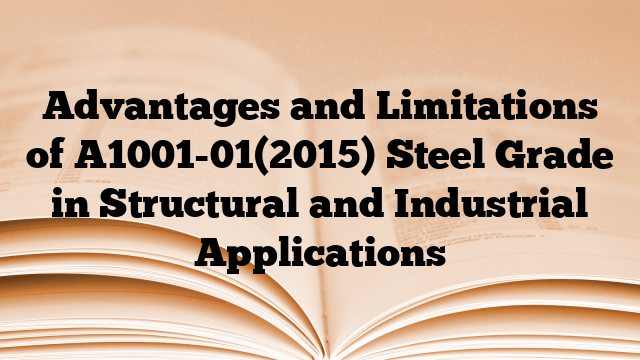Advantages and Limitations of A1001-01(2015) Steel Grade in Structural and Industrial Applications
The A1001-01(2015) steel grade is highly regarded in the construction and industrial sectors due to its unique chemical composition, mechanical properties, and adherence to specific standards. This article aims to explore the advantages and limitations of this steel grade in structural and industrial applications.
Chemical Composition:
The A1001-01(2015) steel grade is primarily composed of iron with specific elements added to enhance its properties. It has a carbon content of 0.25% and manganese content of 1.15%, contributing to its overall strength and durability. Additionally, silicon and copper are added to improve its corrosion resistance. These elements make A1001-01(2015) an excellent choice for structural and industrial applications where resistance to oxidation and atmospheric corrosion is crucial.
Advantages of A1001-01(2015) Steel Grade:
1. High Strength: The carbon and manganese content in A1001-01(2015) steel grade provide exceptional strength, enabling it to withstand heavy loads and structural stresses. This makes it ideal for construction projects that require high-load-bearing capacity, such as bridges and buildings.
2. Corrosion Resistance: The addition of silicon and copper enhances the steel grade’s corrosion resistance, enabling it to withstand harsh environmental conditions. This advantage makes A1001-01(2015) steel grade suitable for industrial applications such as storage tanks, pipelines, and offshore structures that are exposed to corrosive elements.
3. Weldability: A1001-01(2015) steel grade exhibits excellent weldability due to its chemical composition. It can be easily welded using common techniques, allowing for convenient fabrication and construction processes. This makes it a preferred choice in structural and industrial projects where welding is necessary.
Limitations of A1001-01(2015) Steel Grade:
1. Cost: The cost of A1001-01(2015) steel grade may be higher compared to other standard steel grades due to its specific chemical composition and enhanced properties. However, the long-term benefits and durability of this steel grade often outweigh the initial cost, making it a viable investment in the construction and industrial sectors.
2. Brittle Fracture: A1001-01(2015) steel grade exhibits a higher susceptibility to brittle fracture, especially when used in low-temperature environments. Careful consideration should be given to the application and operating conditions to avoid potential failures caused by this limitation. Adequate measures such as proper design, material handling, and temperature control should be taken to mitigate this risk.
In conclusion, the A1001-01(2015) steel grade offers numerous advantages in structural and industrial applications. Its high strength, corrosion resistance, and weldability make it a reliable choice for various projects. However, the potential limitations such as cost and susceptibility to brittle fracture must be carefully evaluated and appropriately addressed to ensure the successful utilization of this steel grade. Overall, when used in accordance with industry standards and with proper precautions, A1001-01(2015) steel grade proves to be a valuable asset in the construction and industrial sectors.

